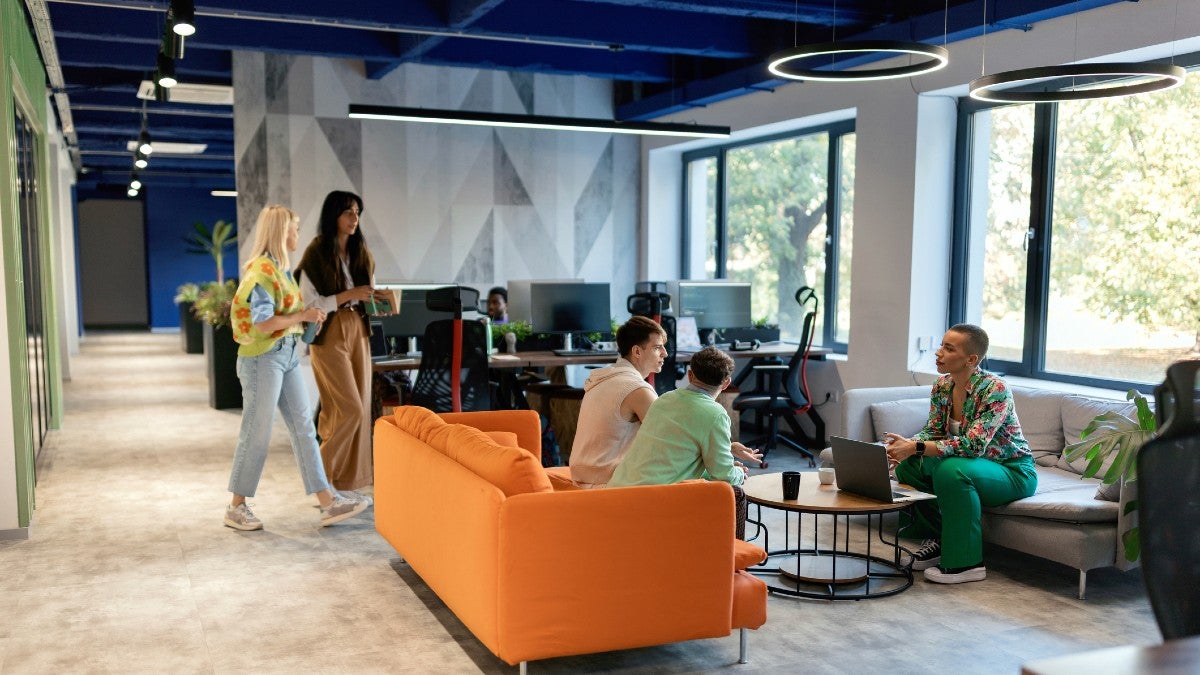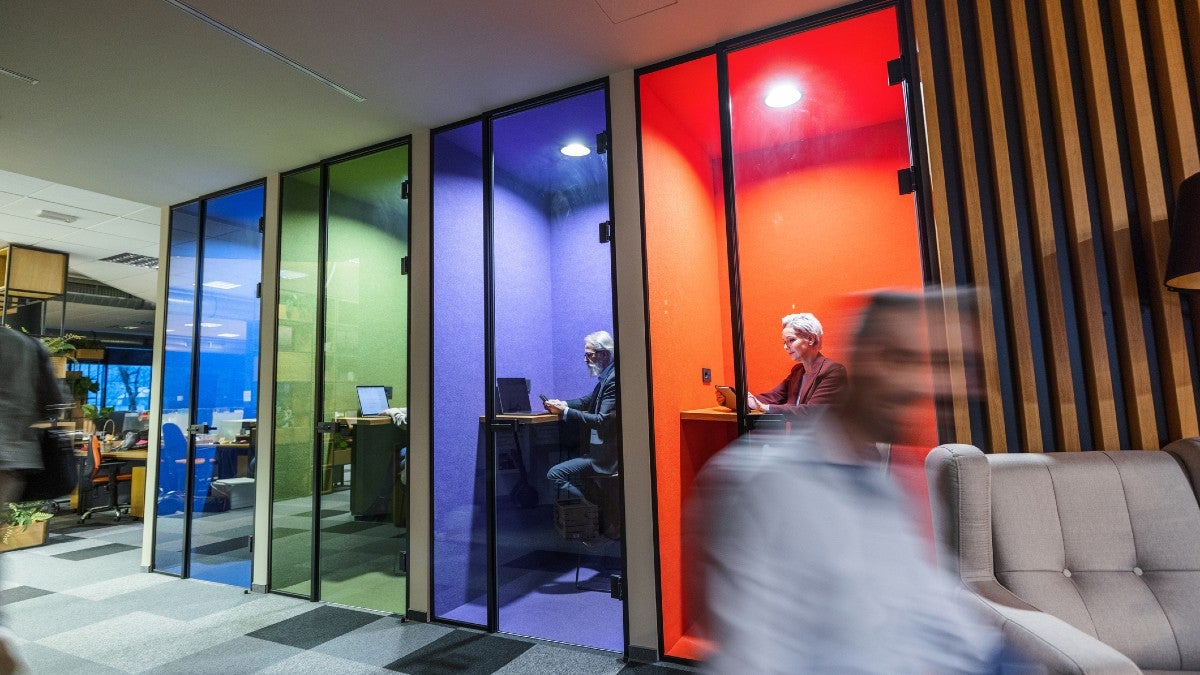The AI advantage: mastering workforce transformation
The secret to success in today’s turbulent times is using technology to help you unlock your talent potential and make faster, more informed decisions

Today, there are few organisations that are not experiencing significant internal or external change. Technology in particular is reshaping how organisations operate at every level. From widening tech skills gaps to the rapid rollout of AI, today’s employers are under pressure to adapt fast. But many are falling behind, struggling to align workforce capabilities with business demands. The result? A global talent crisis that could cost economies over $8.3 trillion by 2030.
While the pressure to adapt is felt across the board, each industry is grappling with its own version of disruption. In financial services, rapid digital transformation and emerging AI capabilities are prompting firms to rethink their operating models – many are recentralising after a period of decentralisation, seeking more control and efficiency, while grappling with cost pressures and AI deployment strategies.
In manufacturing and construction, automation and smart technologies are reshaping how work gets done. The focus has shifted to boosting efficiency and retraining workers to take on new roles in an increasingly digital environment.
These sector-specific responses to change bring various workforce challenges. From headcount reduction and redeployment, to sourcing new skills and reskilling existing teams, businesses across all industries must move fast to keep their people strategy in step with transformation.
Abakar Saidov is executive chairperson of AI talent platform Beamery. As he points out, if employers understand the skills makeup of their workforce and where skills gaps exist, it becomes much easier to make effective talent decisions.
“For example, if you’re going to cut costs or change strategy, you may need to reduce some headcount – but are there other employees who can be retrained and redeployed? Have you identified a vector where you can embed AI agents for customer support or risk management?” he says.
The idea here is to understand not just what skillsets the organisation has today, but also which are required moving forward. Thinking about upskilling existing employees is crucial, not least because it’s expensive to fire and rehire, Saidov notes. But the real issue is that skills needs are constantly changing.
He cites the case of a large construction firm with a UK presence. Over the last 10 years, it has focused on road and rail projects. But it acknowledges that, over the next decade, it will need to reorient its activities towards energy and defence as the market shifts.
As a result, the company has been exploring how best to address its skills needs. While the answer is often to hire in new talent, it is also frequently to upskill and reskill existing employees – or a mixture of both.
But getting hold of the right information and translating complex requirements into actionable, strategic plans can be difficult.
Understanding workforce skills
A major barrier for many employers here is that they struggle to define, assess and compare workforce skills. To make matters worse, they still use a combination of siloed HR and talent management systems that find it difficult to share data about people, tasks and jobs.
This means that understanding the workforce and its skills makeup is usually a time-consuming process – and data is also often out-of-date by the time it is required.
A key problem, Saidov points out, is that: “If you ask a CEO how well they know the organisation’s financial or field operations, they’ll say ‘very well,’ But if you ask them what they know about their people, they’ll say ‘not enough,’ as it’s traditionally been very labour-intensive to find out.”
Traditionally, a consulting firm might have taken many months or even years to evaluate what the skills composition of a given business might be. But innovative AI technology, such as Beamery’s, can now work it out in a couple of hours, Saidov adds. Moreover, the adoption of AI in this context is gathering pace.
“Over the last two years, AI adoption has been relatively slow as organisations took time to become comfortable with how to purchase and embed the technology in their businesses,” Saidov says. “But as McKinsey’s Superagency in the Workplace report reveals, a significant 92% of companies plan to increase their investment in the technology over the next three years.”
Start small and expand
Rather than introduce skills-based initiatives across the business all at once, Saidov advises organisations to “start small and expand.”
“Identify the most critical areas – with talent gaps that can be filled to produce the biggest impact – then test, validate, and learn,” Saidov says. “Many executives want to transform everything, but it’s not just about changing what exists today – it’s also about how much change management your workforce can absorb.”
Once key talent gaps have been identified, the next step is to translate job roles and their underlying tasks into a common language or ‘task taxonomy,’ based on like-for-like definitions. This taxonomy should be tailored to each business, as the language of work varies hugely between companies and industries. Consider ‘project management’ – it can mean something very different in a technical engineering context than it does in marketing or operations. A customised taxonomy ensures that skills are not just identified, but understood in the right context.
AI-based talent platforms, such as Beamery’s, are designed to understand how work gets done across an organisation. By analysing the tasks and skills that underpin each role, these platforms build a real-time picture of what capabilities the business has – and what it needs.
They also assess the skills within the current workforce and compare them with what’s available in the wider talent market. This includes identifying where specific skill sets are most concentrated geographically, as well as factors like cost and talent availability. The result is a set of data-driven recommendations that inform everything from hiring strategies to location planning.
“This is important,” says Saidov, “because the system can clarify the skill sets you have, but it’ll also work out how much retraining of existing employees would be required and what the external market looks like in skills terms – so you can make strategic talent decisions.” Should the company decide to hire externally, it will also evaluate the candidate pool, which includes the wider contingent workforce to see if anyone has the necessary skills to fill a gap.
More broadly, “Skills intelligence enables the system to unpack roles into the job to be done and the skills and tasks required to do it, and employees into their experience, competencies, and the like,” Saidov concluded.
With the right available underlying data, a system like Beamery’s can quickly and accurately match the right people to the right roles.
In other words, not only does having the right tools in place provide greater visibility into skills supply and demand within your organisation – it can help you address your skills requirements and skills gaps in real time too.
By enabling you to make smarter decisions in hiring, internal mobility and employee development terms, this AI-powered skills-based approach helps you deliver a measurable return on investment – and ultimately achieve business goals.
Reducing organisational and talent risk
This approach also enables companies to pinpoint which tasks within a given role are ripe for automation – and thus which people or teams may need to acquire new skills, or be redeployed.
“While some jobs may be automated out, many will also be augmented with AI,” Saidov says. “This means some employees may need upskilling or reskilling – and AI can quickly and easily provide these insights as well. ”
The most popular use case for this kind of approach to date is in supporting the automation of customer support, as it is a straightforward process to tackle.
“Today, customer support people pick up the phone, but tomorrow, they’ll review content to ensure the information provided by bots is correct and that customer experience and Net Promoter Scores are positive,” Saidov explains. “So, it’ll be all about ensuring a good service rather than just manning the phones.”
By identifying which tasks are changing, and how, businesses can act early to equip their people with the right skills – reducing disruption, boosting engagement and retaining valuable institutional knowledge.
While technology is changing the nature of work, it is also helping organisations get the right talent in the right place at the right time. Ultimately, it also reduces organisational and talent risk, by helping executives make better decisions that enhance the company’s competitiveness.
“If you ask a CEO why the business is likely to succeed or fail, it isn’t generally about the strategy but the execution of that strategy. Where things usually fail is in not having the right people doing the right things,” Saidov says.
Aligning talent with business strategy requires more than insight – it demands timely, decisive action, especially as change accelerates and skills needs shift rapidly. “The best way to derisk business outcomes is to derisk your talent decisions,” Saidov concludes.
By embracing AI-powered talent management, organisations can move beyond reactive workforce planning and towards proactive, strategic talent optimisation. This approach aligns people with business priorities, accelerates decision-making and builds a more agile, future-ready workforce.
In a world defined by constant change, the ability to understand and act on skills data isn’t just a competitive advantage – it’s a necessity for long-term success.
Building tomorrow’s talent strategy
To meet the evolving needs of their people and operations, HR leaders need to be proactively thinking about their organisational talent strategy if they are to stay competitive. With the world of work undergoing significant change, firms must strike the right balance between developing internal talent and bringing in new hires with critical skills to meet tomorrow’s challenges.
AI-powered talent: balancing innovation with employee empowerment
AI is reshaping businesses and the roles within them. Leaders must adopt a people-first mindset by fostering transparency, trust and skills alignment for long-term success

AI will reshape organisations’ operating and business models.
This, in turn, will lead to changes in the nature of work, which includes skills requirements, the way jobs are designed, and how people work together.
But such a situation presents leaders with a conundrum: how best to support technological innovation, while alleviating employee concerns around significant workplace change – not least to their jobs.
A recent study by Pew Research reveals that 52% of workers are worried about the impact of AI on their jobs. Some 32% believe it will lead to fewer opportunities, while only 6% expect it to create more employment.
David Liddle is the founder of AiCE (AI Centre of Excellence), president of the People and Culture Association and CEO of mediation firm, TCM Group. He believes that taking a people-first approach to implementing AI is key to tackling such concerns.
“It’s about being intentional and deliberate when working at the intersection between people, organisation and your evolving AI strategy,” Liddle says. “If people have their voices heard, they feel they have agency in shaping and designing the process, so it doesn’t feel like it’s being done to them.”
AI as co-worker, not threat
One way to embed a people-first AI approach is to create a cross-functional working group that brings together employee representatives, line managers and HR to shape the organisation’s AI strategy. By involving people early and openly discussing the vision, risks and opportunities, organisations can build trust and ensure AI is designed to support rather than disrupt.
As Liddle says: “AI is only a threat if it’s allowed to be. But if you want it to be a co-pilot that supports people to do their best work, you can design that into your processes.”
Isobel McWilliams is head of HR at tech consultancy, The Adaptavist Group. She believes that creating a psychologically safe environment for employees is vital due to the disruption AI can generate.
“There’s a lot of fear out there, which means it’s about helping people feel comfortable so they’ll develop a mindset of wanting to move forward,” she says. “So, overcommunicate: it’s essential to explain what you’re doing and why, what change will look like, which includes elements of their job, as well as outcomes and timelines.”
Dr Aaron Taylor, head of the Human Resource Management School at Arden University, agrees.
“Being able to demonstrate benefits is key to effective communication,” Taylor says. “You can talk and people may not believe you, but if you talk and show evidence, it helps with employee engagement and understanding.”
This also includes showing how AI will augment, rather than replace, people’s roles. From streamlining admin to uncovering development opportunities, the technology can free up employees to focus on more meaningful and strategic work. As Taylor notes, “It’s about human amplification – not substitution.”
Aligning skills to business needs
Just as important is creating a culture of continuous learning, which includes both ‘hard’ and ‘soft’ skills. Ensuring employees have the right expertise for the future not only helps in attracting and retaining talent, it also provides employees with a pathway to achieving their professional and organisational goals.
Liddle warns though: “Managers continue to disregard soft skills in favour of technical skills, but they’ll be essential to the successful organisations of the future. These core skills are necessary to achieve the organisation’s goals and to ride the storms that are creating so much rapid change.”
As to understanding what skills, both hard and soft, the organisation requires, the best place to start is with a skills audit. This includes a skills assessment and mapping exercise to help employers understand their current situation – and where any skills gaps may exist.
The aim here is to ensure you are hiring and developing skills in line with business needs, and that any upskilling and reskilling requirements feed into personalised employee development plans and pathways.
Ironically, this is a project AI can actually help with. AI-based talent management systems now make it easier to map skills to roles and people by analysing dynamic data from across the business. This gives HR a real-time view of skills, helps spot gaps faster, and supports smarter decisions around hiring, development and internal mobility.
Such tools also enable leaders to match people to stretch assignments or emerging roles, helping retain high performers while building a more agile workforce.
HR driving improvement for tomorrow
A significant challenge for HR leaders here is to redesign traditional, siloed job roles so that employees are no longer identified with single, specific job titles.
Instead, the aim is to create more fluid, adaptable roles, based around the language of skills and tasks, that enable the business to adjust as needed to a rapidly changing world. These more fluid roles enable employees to apply their particular skills across different projects and functions, as required.
“To ensure a culture of continual improvement and adaptation, you need to shift the focus from traditional job design to focus on individual skills,” Liddle points out. “It’s about continuously reviewing, evolving, shaping and developing your talent and skills requirements to ensure they align with organisational strategy.
AI can now play a key role in this process. Providing access to dynamic, real-time data, AI helps organisations keep skills and job intelligence current, actionable and better aligned to changing business needs.”
This is where a supportive learning ecosystem becomes crucial. From microlearning platforms to AI-curated development pathways, today’s tools allow employees to build relevant skills on demand – and give HR the visibility to ensure learning efforts are delivering real value.
“Without a culture of learning, you risk losing both your top talent and your competitive edge,” McWilliams adds. “Employees want to grow – and in an AI-shaped landscape, that means having the tools and support to evolve continuously.”
But this change is also leading to a shift in the role of many HR teams as they morph into more proactive ‘people and culture’ functions.
“They’re taking on a more supportive enabling and facilitation role, by undertaking skills gap analyses and helping managers with coaching and mentoring. And this kind of tripartite relationship is building an unstoppable force in driving improvement for tomorrow,” Liddle concludes.
As agentic AI reshapes the world of work, organisations must match innovation with intentionality. That includes grounding AI in human values, widening access to opportunity, and fostering an inclusive, resilient culture. Those that centre people in their strategy – empowering them with the skills, clarity and confidence to adapt – will be the ones that thrive.


